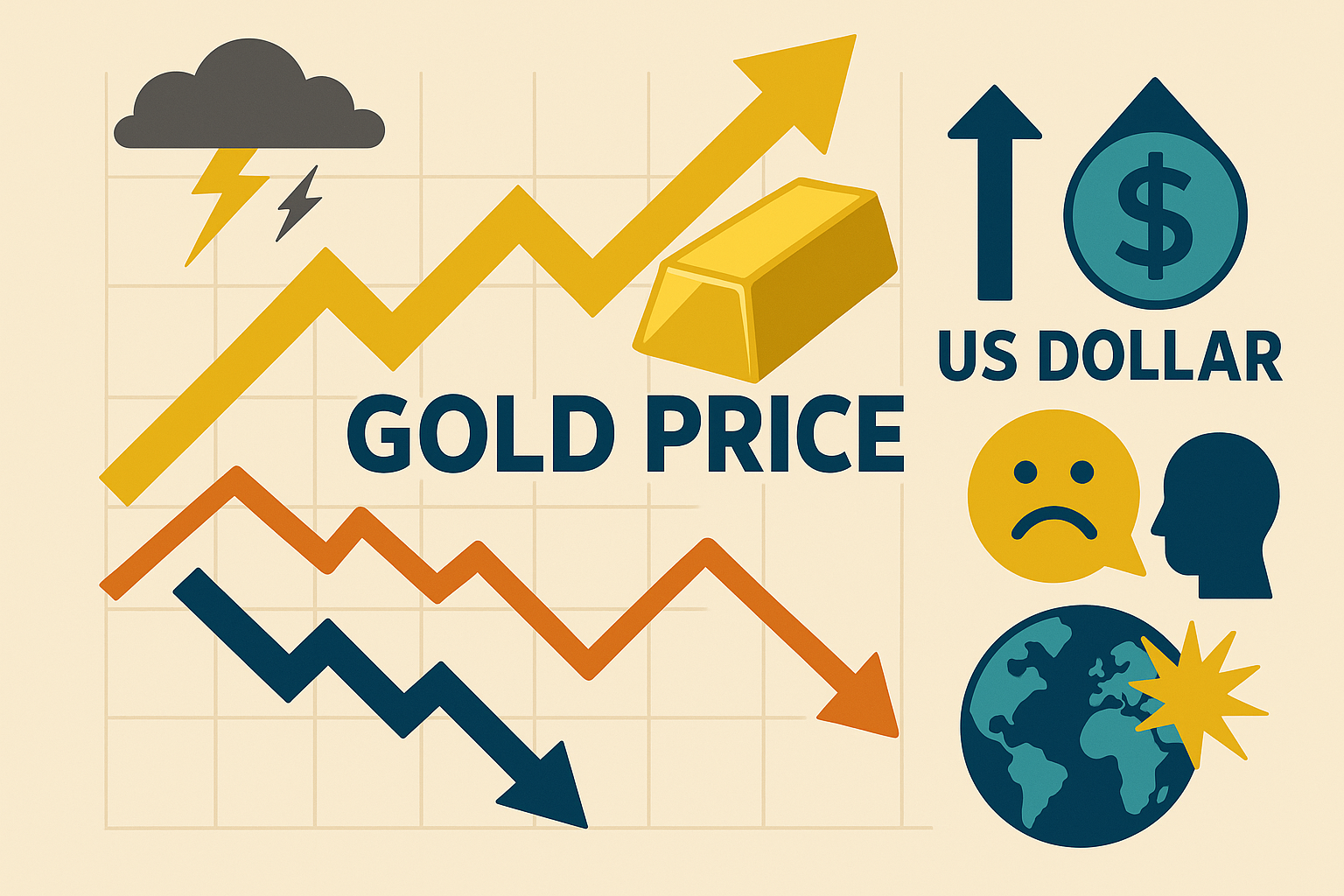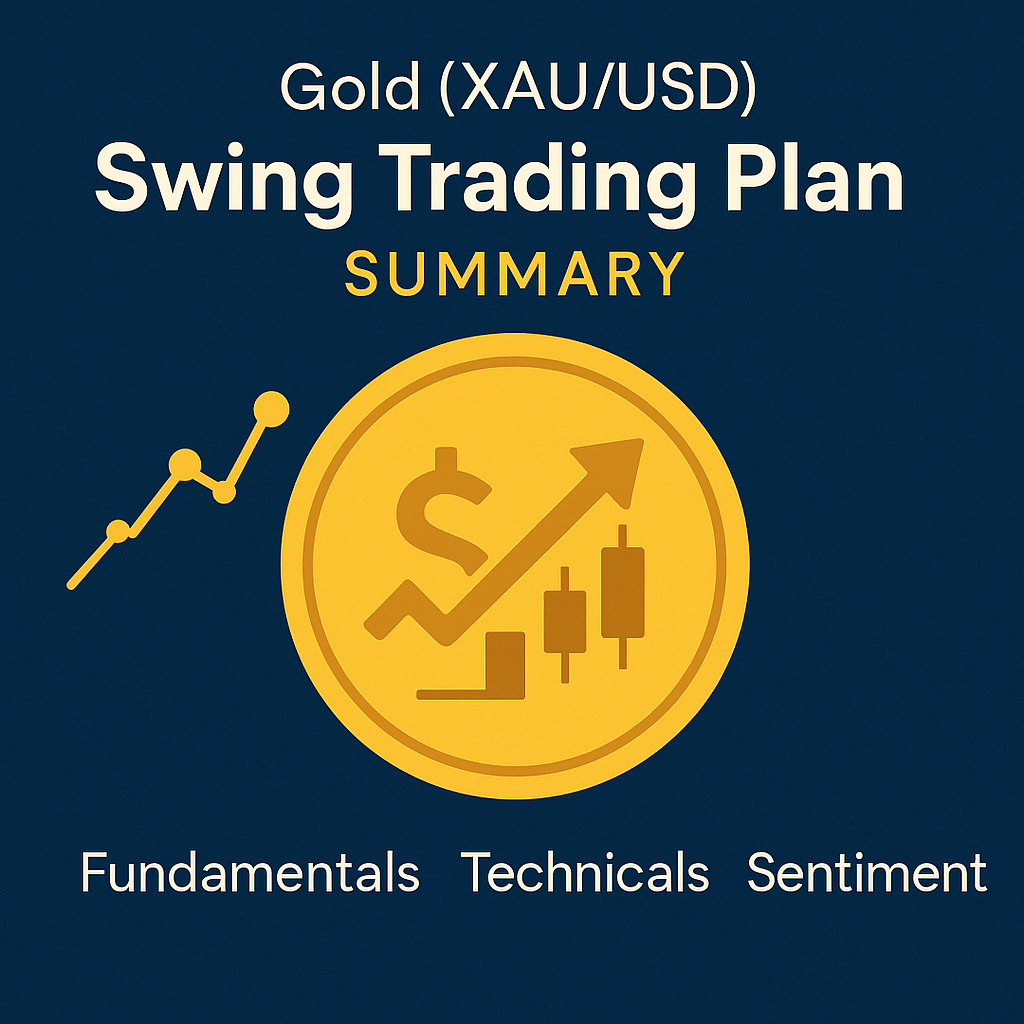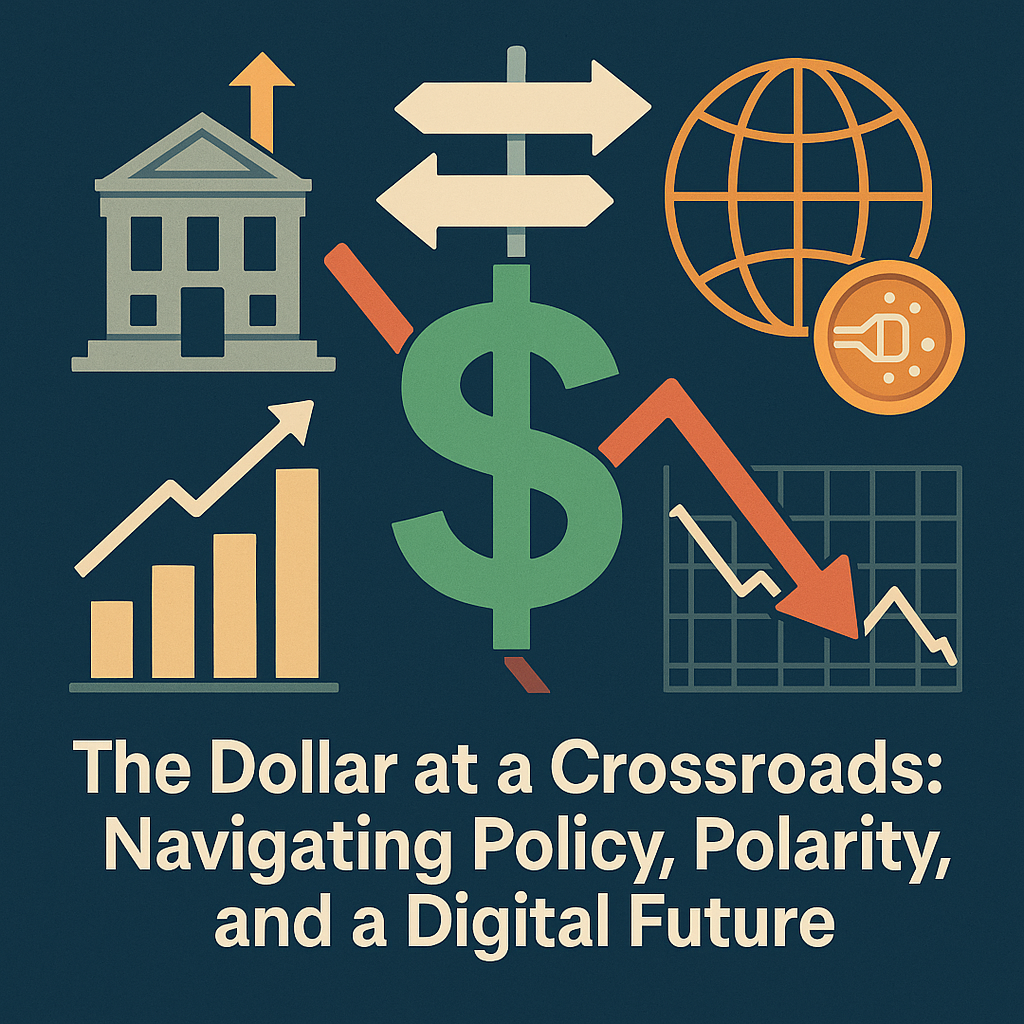Gold's Short-Term Trajectory: Navigating Divergent US Data, Dollar Dynamics, and Geopolitical Crosscurrents
An In-depth Analysis for Fundure Research
By Md Mohibullah
I. Executive Summary
Gold's recent price action indicates a struggle for directional clarity, currently testing critical support levels after a pullback from its recent highs. The technical zone of $3280-$3300 per ounce is a paramount area of focus for market participants. Recent United States economic data presents a complex and somewhat divergent picture: consumer sentiment data from the Conference Board showed a significant rebound, while the University of Michigan survey indicated a continued decline with surging inflation expectations. The preliminary Q1 2025 Gross Domestic Product (GDP) revealed an unexpected contraction, primarily attributed to a surge in imports, likely driven by businesses pre-empting tariffs, and a decrease in government spending.
The US Dollar Index (DXY) has maintained its strength in the first half of 2025, primarily propelled by perceived US economic exceptionalism and a notable divergence in monetary policy between the Federal Reserve and other major central banks, such as the European Central Bank. While a strong dollar is traditionally considered bearish for gold, an evolving relationship has been observed, with both assets acting as safe havens amidst heightened geopolitical tensions and persistent central bank diversification efforts. Global economic developments, particularly ongoing trade disputes and the varied pace of monetary policy adjustments across major central banks, will continue to exert significant influence on gold's appeal.
The immediate outlook for gold's short-term trajectory hinges critically on tomorrow's revised Q1 GDP data, the market's nuanced interpretation of the conflicting consumer sentiment reports, and the ongoing impact of tariff dynamics. A retest of the $3350 lower high appears challenging in the immediate term given the prevailing "risk-on" sentiment following recent tariff delays. Conversely, the $3280-$3300 support zone remains vulnerable to further downside if this risk-on appetite persists or if the dollar strengthens further on robust US economic signals.
II. Gold's Current Technical Posture and Recent Performance
Gold has experienced notable volatility in recent weeks, characterized by a significant rally that saw prices climb nearly 5% to a "record zone" around $3,350 an ounce last week.[1] However, this rally was followed by a pullback, with gold prices experiencing fluctuations and testing lower levels. This volatility is a reflection of shifting inflation expectations, fluctuating Treasury yields, and dynamic demand for safe-haven assets and diversification.[2]
The user query identifies $3280-$3300 as a critical support area. Recent market data confirms that gold has traded around and even below this range. Following the University of Michigan consumer sentiment release, spot gold fell to $3,184.52 per ounce.[3] Similarly, after the Conference Board data, spot gold dropped to $3,297.15 per ounce.[4, 5] Reports also indicate gold "bottoming out around $3,200 in mid-May".[2] Recent gold futures prices were observed between $3,295.00 and $3,365.80 per ounce.[6] These data points collectively underscore that the $3280-$3300 zone has served as a significant area of interest for price action, but it has been breached, indicating its vulnerability as a definitive floor.
The $3,350 level was recently established as a "newly set lower high" and a "record zone" for bullion.[1] However, gold prices experienced a decline to $3,337.64 per ounce [1] immediately after U.S. President Donald Trump announced a postponement of planned 50% tariffs on European Union goods until July 9. This easing of trade tensions led to a shift in market sentiment away from safe-haven assets. The immediate drop in gold prices directly after President Trump's announcement regarding the delay of EU tariffs suggests a clear cause-and-effect relationship: a reduction in trade fear translates to diminished safe-haven demand for gold.[1] This observation is reinforced by the market's reaction to consumer confidence data. Gold fell when the Conference Board consumer confidence index rose.[4, 5] Improved consumer confidence typically signals economic optimism and a shift towards riskier assets like equities, moving capital away from safe havens. The Conference Board rebound "gained momentum afterwards" the May 12 trade deal [4], further solidifying the link between easing trade tensions and a shift in market sentiment. Furthermore, gold also fell when the University of Michigan consumer sentiment deteriorated and inflation expectations spiked.[3] While spiking inflation expectations are traditionally bullish for gold as an inflation hedge, the overall market reaction suggests that the immediate "risk-on" narrative stemming from tariff delays was more dominant. The market appeared to prioritize the perceived reduction in immediate systemic risk over the inflation-hedge aspect of gold in this specific instance. The consistent downward pressure on gold across seemingly contradictory sentiment data points (improving confidence versus deteriorating confidence) points to a dominant narrative of "reduced immediate risk" due to tariff delays. This "risk-on" environment pulls capital away from safe-haven assets like gold towards equities. For gold to retest $3350, a significant shift back to risk-off sentiment or renewed geopolitical/trade uncertainty would be required.

Figure 1: Gold Price Reactions to Key Events in May 2025. This chart illustrates the immediate impact of significant economic and geopolitical announcements on gold prices.
In terms of critical technical levels, the $3280-$3300 zone, as highlighted in the query, remains a significant area. However, recent lows around $3,200 [2] and $3,184.52 [3] suggest that if this primary support fails to hold, further downside is plausible towards these lower levels. The $3,350 level [1] represents a significant resistance point that gold struggled to sustain. Nevertheless, the "ravenous pace" of central bank gold buying [2] is noted to put a "solid floor" under prices, suggesting that any significant short-term decline might be limited in its overall scope, providing a long-term structural support.
III. US Economic Fundamentals: A Week in Review
This section delves into the key economic data releases that influenced market sentiment during the week. Understanding these indicators is crucial for gauging inflationary pressures, labor market health, and potential shifts in monetary policy. Click on each section below to explore the details and Fundure's interpretation.
The latest consumer sentiment data from the United States presents a contrasting picture from two prominent surveys.
Conference Board Consumer Confidence (May 2025):
The Conference Board's consumer confidence index demonstrated a significant rebound in May, rising by 12.3 points to 98.0, a notable improvement from April's downwardly revised 85.7. This marked a reversal after five consecutive months of declines.[4, 5, 7] The measure of Americans' short-term expectations for income, business conditions, and the job market also saw a substantial jump of 17.4 points to 72.8, though it remained below 80, a level that can signal a recession ahead.[4, 7] Consumers expressed reduced pessimism regarding business conditions and job availability over the next six months, coupled with renewed optimism about future income prospects.[4] This improvement was notably visible even before the May 12 US-China trade deal and gained further momentum afterwards.[4] Following the release of this stronger-than-expected data, gold prices fell to fresh session lows, with spot gold trading at $3,297.15 per ounce, marking a loss of 1.35% on the session.[4, 5]
University of Michigan Consumer Sentiment (Preliminary May 2025):
In contrast, the preliminary reading of the University of Michigan's Consumer Sentiment survey for May declined to 50.8, falling below April's final reading of 52.2 and missing economists' consensus forecast for an improvement to 53.4.[3, 8, 9] Overall sentiment is now down almost 30% since January 2025.[3, 9] Current assessments of personal finances deteriorated significantly, sinking nearly 10% on the basis of weakening incomes.[3, 9] Tariffs continued to be a dominant concern, spontaneously mentioned by nearly three-quarters of consumers, up from almost 60% in April, largely shaping their views on the economy.[3, 9] A critical component of the UMich survey showed year-ahead inflation expectations surging from 6.5% last month to 7.3% this month. Long-run inflation expectations also lifted from 4.4% in April to 4.6% in May, reflecting a particularly large monthly jump among Republicans.[3, 9] The gold market was trading lower, with spot gold last seen at $3,184.52 per ounce for a loss of 1.71% on the day, following this data release.[3]
The stark divergence between the Conference Board's reported rebound and the University of Michigan's continued decline in consumer sentiment, coupled with gold's similar negative reaction to both releases, highlights a complex and potentially contradictory market interpretation. The most immediate and striking observation is the direct contradiction between the Conference Board indicating a rebound in consumer confidence and the University of Michigan showing a continued decline. This signals a need for deeper analysis, not just reporting. Crucially, gold fell after both the positive Conference Board data and the negative University of Michigan data. This is counter-intuitive if gold were reacting purely as a safe-haven (negative sentiment should be bullish) or a pure inflation hedge (spiking inflation expectations from UMich should be bullish). The common thread across multiple reports is the easing of trade tensions due to President Trump's tariff delay.[1, 4] The Conference Board rebound "gained momentum afterwards" the May 12 trade deal.[4] One report explicitly states gold's dip is "directly linked to easing concerns over trade tensions" and that "the market has shifted focus from currency strength to risk appetite" with investors putting money back into stocks.[1] This leads to the conclusion that the market's primary focus, at least in the very short term, is on the reduction of immediate, headline-driven risks, such as trade wars. This fosters a "risk-on" environment where capital flows out of safe-haven assets like gold. Even data that might otherwise suggest a need for a safe-haven (like deteriorating UMich sentiment) or an inflation hedge (like rising UMich inflation expectations) is overshadowed by the perceived improvement in global risk appetite. This implies that the market is currently less concerned about the long-term implications of the UMich inflation spike for Fed policy (i.e., potential higher rates) and more about the immediate shift in risk sentiment. This conflict between historical signals and current specific drivers makes gold's reaction to tomorrow's GDP data particularly complex.
Table 1: Comparison of May 2025 US Consumer Sentiment Indices
| Index/Measure | May 2025 Value | April 2025 Value | May 2024 Value | Change M-M | Change Y-Y | Source |
|---|---|---|---|---|---|---|
| Conference Board Consumer Confidence Index | 98.0 | 85.7 | N/A | +12.3 | N/A | [4, 7] |
| Conference Board Expectations Index | 72.8 | N/A | N/A | +17.4 | N/A | [4, 7] |
| University of Michigan Consumer Sentiment | 50.8 | 52.2 | 69.1 | -2.7% | -26.5% | [3, 8, 9] |
| UMich Current Economic Conditions | 57.6 | 59.8 | 69.6 | -3.7% | -17.2% | [9] |
| UMich Index of Consumer Expectations | 46.5 | 47.3 | 68.8 | -1.7% | -32.4% | [9] |
| UMich Year-Ahead Inflation Expectations | 7.3% | 6.5% | N/A | +0.8% | N/A | [3, 9] |
| UMich Long-Run Inflation Expectations | 4.6% | 4.4% | N/A | +0.2% | N/A | [3, 9] |

Figure 2: Comparison of US Consumer Sentiment and Inflation Expectations (May vs. April 2025). This bar chart highlights the divergent trends observed in the Conference Board and University of Michigan surveys for May 2025 compared to April 2025.
Q1 2025 Advance Estimate Review:
The U.S. Bureau of Economic Analysis (BEA) reported that Real Gross Domestic Product (GDP) decreased at an annual rate of 0.3 percent in the first quarter of 2025 (January, February, and March).[10, 11, 12, 13, 14] This represents a notable deceleration from the 2.4 percent increase observed in the fourth quarter of 2024.[10] This contraction marks the first negative quarterly growth since Q1 2022 and the first overall contraction in three years.[12, 13]
The primary drivers of this contraction were a significant increase in imports (which are a subtraction in GDP calculation) and a decrease in government spending.[10, 11] The elevated level of imports was "likely due to businesses frontrunning Trump's import tariffs," a phenomenon further corroborated by the largest build in private inventories since Q4 2021.[12] This suggests a strategic, rather than purely demand-driven, import surge. The decline in government spending was led by a decrease in federal government consumption expenditures (particularly defense), partly offset by an increase in state and local government spending. Cuts from the Department of Government Efficiency (D.O.G.E.) were explicitly cited as contributing to this pullback.[10, 12] These negative contributions were partly offset by positive increases in investment, consumer spending, and exports.[10, 11] Despite the overall contraction, inflationary pressures were evident, with the price index for gross domestic purchases increasing 3.4 percent in Q1 (up from 2.2% in Q4 2024), and the personal consumption expenditures (PCE) price index increasing 3.6 percent (up from 2.4%). Excluding food and energy, the core PCE price index rose 3.5 percent.[10, 11]
Analyst Expectations and Potential Revisions for Tomorrow's Second Estimate:
The advance estimate of -0.3% was lower than the consensus forecast of 0.2%.[13] Alternative forecasts varied: the widely referenced Atlanta Fed GDPNow economic model projected a more substantial contraction of -2.8% for Q1 2025, while an alternative model (adjusting for imports and exports of gold) projected -0.5%.[15] BNP Paribas reported a Q1 2025 contraction of -0.1% quarter-over-quarter.[16] It is crucial to note that the advance estimate will undergo two further revisions and a final annual revision.[10, 12] Historically, these revisions can significantly alter the final reported figures.[12] The next release, the "Gross Domestic Product (Second Estimate)," is scheduled for May 29, 2025, at 8:30 a.m. EDT.[10]
The Q1 GDP contraction, while a headline negative, is heavily influenced by a surge in imports driven by businesses "frontrunning" anticipated tariffs.[12] This suggests that the underlying domestic demand might be stronger than the headline GDP figure implies, as evidenced by continued increases in consumer spending and investment.[10, 11, 12] A negative GDP reading is typically interpreted as a sign of economic weakness, which would generally be bullish for safe-haven assets like gold. However, the largest negative contributor to GDP was imports, which is a critical detail that goes beyond the headline. The fact that this high level of imports is "likely due to businesses frontrunning Trump's import tariffs" [12] indicates a specific, policy-driven, and potentially one-off event, not necessarily indicative of a fundamental collapse in domestic demand. Despite the overall GDP contraction, consumer spending (both goods and services) and investment still showed positive contributions.[12] If market participants understand that the primary drag on GDP was a technical distortion related to tariff anticipation, rather than a genuine, broad-based economic slowdown, the safe-haven demand for gold might be muted. The market may "look through" the headline negative number, reducing the urgency for gold as a recession hedge, especially if combined with the "risk-on" sentiment from tariff delays.[1] This implies that the quality of the GDP contraction matters as much as the quantity.
Table 2: US Real GDP Q1 2025 Advance Estimate: Component Contributions
| Component of U.S. GDP Change | Change in Q1 2025 (percentage points) |
|---|---|
| Consumer Spending (goods) | 0.1 [12] |
| Consumer Spending (services) | 1.1 [12] |
| Investment | 3.6 [12] |
| Government spending | -0.3 [12] |
| Exports | 0.2 [12] |
| Imports | -5.0 [12] |
| Q1 2025 Real GDP Change | -0.3 [12] |

Figure 3: Contributions to US Real GDP Growth in Q1 2025. This chart breaks down the percentage point contributions of various components to the overall Real GDP change in the first quarter of 2025.
Historical Relationship between US GDP Growth and Gold Prices:
Gold is widely considered a "non-confidence vote in the U.S. economy".[17] According to the safe-haven channel theory, there should be a negative correlation between GDP growth and the price of gold: when the economy expands, investment demand for gold as a safe-haven tends to fall, and vice versa.[17] While some theories suggest faster economic growth boosts demand for gold due to rising incomes, this source expresses skepticism, arguing that gold prices are primarily driven by investment demand, not consumer demand.[17] Gold has historically acted as a leading indicator, signaling a high probability of recessions earlier than official GDP data.[17] For example, gold signaled a recession in Q4 2005, while GDP declined much later in Q3 2008.[17]
The impact of GDP growth on the gold market is not always straightforward and can vary significantly. Much depends on the prevailing economic trend, the specific sources of growth (e.g., growth boosted by monetary stimulus or government fiscal deficits may also see gold prices rise), and crucially, how the growth data will influence the Federal Reserve's monetary policy actions.[17] Strong GDP growth typically warrants restrictive monetary policy, which is generally bearish for gold, provided it's not "jobless growth".[17]
While a negative GDP reading historically aligns with gold's safe-haven appeal and its role as a leading indicator of recession [17], the specific drivers of this Q1 contraction, namely tariff front-running imports [12], introduce a critical nuance. The historical precedent clearly positions gold as a safe-haven asset that often moves inversely to GDP growth, and importantly, as a leading indicator for recessions. A negative GDP should, in theory, be bullish for gold. The Q1 2025 GDP reading is indeed negative, which, based on historical patterns, would suggest a bullish outlook for gold. However, the detailed breakdown of the GDP components reveals that the largest drag was from imports, specifically due to businesses "frontrunning Trump's import tariffs".[12] This is a technical distortion rather than a sign of fundamental economic collapse. The market is sophisticated and will likely differentiate between a genuine, broad-based economic slowdown (which would trigger strong safe-haven demand for gold) and a temporary, policy-induced distortion. If the market interprets the Q1 GDP contraction as the latter, the typical "recession signal" for gold might be muted. This muted reaction is further reinforced by the current "risk-on" sentiment stemming from the delay in EU tariffs.[1] When immediate headline risks recede, even negative economic data might not spur a strong safe-haven bid if the underlying cause is seen as temporary or manageable. This conflict between historical signals and current specific drivers makes gold's reaction to tomorrow's GDP data particularly complex.
IV. Macroeconomic Drivers: The US Dollar and Global Landscape
A. The US Dollar Index (DXY): Sustained Strength and Future Path
Recent Trends:
The US Dollar Index (DXY) has demonstrated sustained strength in 2025, reaching its highest level since November 2022 and trading above the 110 level intra-session. It has appreciated by approximately 9% since late September.[18, 19]
Drivers of Strength:
The dollar's resilience is underpinned by several key factors. Firstly, "US economic exceptionalism" continues to support a strong dollar. Stronger-than-expected US economic data, including nonfarm payrolls and the services sector purchasing managers' index, has fueled expectations for continued US economic robustness. This contrasts with subdued growth prospects elsewhere, particularly in Europe, making the US a relatively more attractive investment destination.[18, 19] Secondly, a significant driver of DXY strength is the divergence in monetary policy between the Federal Reserve and other major central banks. While UBS expects the Fed to cut rates twice in 2025 (totaling 50 basis points of easing) in the second and third quarters, the European Central Bank (ECB) is anticipated to cut rates more aggressively, by 100 basis points in the first half of 2025.[18, 20] The ECB already initiated a 25 basis point cut in March 2025.[5, 16, 21] This policy divergence, with the Fed holding steady or easing more slowly, makes dollar-denominated assets more appealing due to higher relative yields, thus strengthening the DXY.[18, 19] Thirdly, the potential for new tariffs, if they materialize, could lead to further USD appreciation, as these risks do not appear to be fully priced in. Concerns over the inflationary impact of such tariffs are dominating market narratives in the near term.[18, 19]
Correlation with Gold:
The relationship between gold and the U.S. dollar has historically been inverse: when the dollar strengthens, gold typically weakens, and vice versa.[22, 23] This is primarily because gold is priced in dollars globally, meaning a stronger dollar makes gold more expensive for investors holding other currencies, thereby dampening demand. Additionally, gold becomes less attractive as a non-yielding asset when the dollar strengthens and U.S. interest rates rise, making dollar-denominated assets more appealing to investors seeking returns via yields.[22, 23]
However, 2023 and 2024 witnessed an unusual phenomenon where both gold and the dollar demonstrated significant strength simultaneously.[22] This "evolving relationship" was driven by several factors. Geopolitical tensions, including the Russia-Ukraine conflict and Middle East instability, drove safe-haven demand for both gold and the dollar.[22] Furthermore, central banks, particularly China and Russia, significantly increased their gold reserves to diversify away from dollar-denominated assets, providing steady support for gold prices despite dollar strength.[22] Persistent inflation concerns also kept gold attractive as a traditional inflation hedge, especially when market participants anticipated rising inflation but expected the Fed to remain accommodative or even implement rate cuts, leading to lower real interest rates.[22]

Figure 4: Gold Price vs. DXY Index in May 2025. This chart illustrates the concurrent movements of gold prices and the US Dollar Index (DXY) during May 2025, highlighting their evolving correlation.
While some signs point to a partial normalization of the gold-dollar relationship as the Federal Reserve transitions from its tightening cycle to potential easing, structural changes and global uncertainties suggest that this correlation could remain fluid. Heightened global uncertainties, including ongoing trade disputes and geopolitical conflicts, can drive simultaneous demand for both gold and the dollar when they are both seen as safe-haven assets, potentially disrupting the historical inverse correlation.[22] Market analysts increasingly emphasize that gold's price is now more influenced by real interest rates, inflation concerns, and systemic risks rather than solely by dollar strength.[22]
The DXY's influence on gold is dual and complex. While DXY strength is traditionally bearish for gold, its drivers matter significantly. If DXY strengthens due to a broad "risk-off" sentiment (e.g., global instability, a flight to safety), gold might also rise as both act as safe havens. Conversely, if DXY strengthens due to "US economic exceptionalism" (e.g., higher relative yields, better economic growth), it typically exerts downward pressure on gold. The current environment is a blend of these dynamics. The recent tariff delays, while easing specific trade fears and fostering a "risk-on" environment for equities, might also imply less immediate need for the dollar as a safe haven. This could allow for a more traditional inverse relationship to reassert itself, where a stronger dollar (driven by US economic outperformance) would weigh on gold, especially if the "risk-on" narrative for equities persists.[1, 18, 19, 22] The market's interpretation of the cause of dollar strength is therefore critical for gold's short-term reaction.
B. Global Economic Developments and Geopolitical Crosscurrents
Global Inflation Outlook:
Global headline inflation is expected to decline steadily, with the International Monetary Fund (IMF) forecasting a drop to 4.2 percent in 2025 and 3.5 percent in 2026. Inflation is projected to converge back to target earlier in advanced economies than in emerging market and developing economies.[24, 25] However, this forecast appears optimistic given present trade tensions and ongoing policy uncertainty.[21]
Major Central Bank Monetary Policy Outlook:
Monetary policy in 2025 is largely characterized by central banks aiming to bring interest rates to neutral levels that neither stimulate nor cool the economy.[20] The European Central Bank (ECB) has already initiated an easing cycle, cutting its policy rate by 25 basis points in March 2025 to 2.5 percent (the sixth rate cut since June 2024).[5, 16, 21] The ECB is expected to continue cutting rates, potentially reaching neutral territory as early as 2025, given tepid growth in the euro area and the expectation that inflation will settle around the 2% target.[20] In contrast, the US Federal Reserve (Fed) maintained its federal funds target range of 4.25 percent to 4.50 percent in March 2025.[16, 21] While the Fed is still expected to cut rates twice in 2025 (totaling 50 basis points of easing), these reductions are not anticipated until the second and third quarters.[18, 19, 20] The Fed's stance is to reach neutral levels during 2025 to avoid a sudden cooling of the labor market amidst a disinflationary process.[20] This divergence in policy—ECB easing more aggressively while the Fed holds steady or eases more slowly—is a powerful driver of currency trends, supporting the US dollar.[18, 19]
Geopolitical Tensions and Trade Wars:
Geopolitical events continue to exert a significant influence on gold prices. Gold prices experienced a decline recently after U.S. President Donald Trump announced a postponement of planned 50% tariffs on European Union goods until July 9.[1] This decision eased market fears related to an immediate trade war, weakening safe-haven demand for gold.[1] When equities rise in reaction to reduced global risks, it typically diminishes the appeal of safe-haven assets like gold.[1]
However, despite this temporary easing of trade tensions, broader geopolitical risks have not dissipated. Tensions continue in Ukraine, where Russia launched new aerial attacks recently.[1] Such ongoing conflicts could keep gold attractive to cautious investors.[1] Central banks globally are also continuing their substantial gold buying, reflecting a structural shift towards diversification away from dollar reserves and providing a "solid floor" under gold prices.[2, 3, 22] This reflects a broader global context of a shift from a "unipolar world centered around the dollar to a multipolar world," increasing the importance of gold as a reserve asset.[3]
Geopolitical events inherently create market volatility. Gold acts as a safe haven during periods of uncertainty, but its reaction depends on the specific nature of the event and its impact on other asset classes, such as the dollar or equities. The recent tariff delay example demonstrates how easing specific, high-profile tensions can temporarily reduce gold's immediate safe-haven appeal, even if broader instability persists.[1] This suggests that while gold benefits from overall uncertainty, the market differentiates between acute, headline-driven risks (which, when resolved, can lead to gold pullbacks) and chronic, underlying geopolitical instability (which provides structural support). The sustained, ravenous pace of central bank gold buying provides a significant structural floor for prices, indicating that any short-term declines due to easing headline risks might be limited in their overall scope.[2]
V. Short-Term Gold Price Outlook and Scenarios
The short-term trajectory of gold prices will be determined by a complex interplay of the fundamental and technical factors discussed. The market is currently navigating conflicting signals from consumer sentiment, a nuanced GDP contraction, persistent dollar strength, and an evolving geopolitical landscape.

Figure 5: Gold Price Scenario Forecast (May 27 - June 2, 2025). This chart visualizes the three potential short-term trajectories for gold prices, including a retest of $3350, a decline towards $3185, and stabilization near $3290.
Scenario 1: Retest of $3350 (Less Likely in Immediate Term)
For gold to retest the newly established lower high around $3350, a significant shift back to a "risk-off" sentiment would be required. This could be triggered by a renewed escalation of trade tensions, for instance, if the US-EU tariff negotiations fail to progress before the July 9 deadline, or if new tariffs are unexpectedly imposed. Alternatively, a more severe interpretation of tomorrow's revised Q1 GDP data, perhaps indicating a deeper, more fundamental economic malaise rather than a tariff-induced distortion, could also spur a flight to safety. However, given the current market sentiment, which has seen capital flow into equities following the recent tariff delays, a rapid retest of $3350 appears less probable in the immediate short term. The market's current focus on reduced headline risks makes a strong safe-haven bid challenging.
Scenario 2: Continued Downside to Lower Support Levels (More Likely in Immediate Term)
If the prevailing "risk-on" sentiment persists, fueled by continued perceived easing of trade tensions and a stronger equity market, gold could face further downward pressure. If the US dollar strengthens further, driven by continued US economic exceptionalism and higher relative yields compared to other major economies, this would traditionally weigh on gold prices. Furthermore, if tomorrow's Q1 GDP revision is interpreted by the market as a temporary, technical distortion rather than a fundamental economic weakness, gold's role as a recession hedge might be muted. Gold has already shown vulnerability below the $3280-$3300 zone, with recent lows around $3200 and $3184.52. Therefore, a continued decline towards these lower levels is plausible if the current market dynamics favoring risk assets remain dominant.
Scenario 3: Stabilization around $3280-$3300 (Plausible, but Vulnerable)
Gold could find some stabilization around the $3280-$3300 zone if market participants remain cautious despite the recent tariff delays, or if tomorrow's GDP revision is only marginally negative and the "tariff distortion" narrative holds sway. This zone has been a key area of price interaction. The underlying structural support from the continuous and "ravenous pace" of central bank gold buying [2] also provides a solid floor, potentially limiting any significant short-term declines and allowing for consolidation around these levels. However, this stabilization remains vulnerable to strong directional impulses from upcoming economic data or geopolitical developments.
Key Catalysts to Watch:
The immediate trajectory of gold will be heavily influenced by:
- Tomorrow's Q1 2025 GDP Second Estimate (May 29, 2025): The market's interpretation of this revision, particularly whether it reinforces the "tariff-induced distortion" narrative or signals deeper economic weakness, will be critical.
- Evolution of US-EU Trade Talks: Progress or setbacks in negotiations ahead of the July 9 tariff deadline will directly impact market sentiment and gold's safe-haven demand.
- Any Major Geopolitical Flare-ups: Renewed escalation in existing conflicts or emergence of new geopolitical tensions could quickly reignite gold's safe-haven appeal.
- Upcoming Federal Reserve Meeting in June: Signals regarding future interest rate policy, especially any shifts in tone around potential rate cuts, will influence real interest rates and the dollar, thereby impacting gold.
- Further Developments in US Consumer Confidence and Inflation Expectations: While currently overshadowed by trade dynamics, persistent high inflation expectations or a sustained decline in consumer confidence could eventually reassert gold's role as an inflation hedge or safe haven.
VI. Conclusions and Recommendations
The short-term outlook for gold is characterized by a complex interplay of conflicting economic signals and shifting market sentiment. The divergence between the Conference Board's rebound in consumer confidence and the University of Michigan's continued decline, coupled with gold's negative reaction to both, indicates that the market is currently prioritizing the perceived easing of immediate trade tensions over nuanced domestic economic readings or even rising inflation expectations. The Q1 2025 GDP contraction, while a headline negative, appears to be significantly influenced by a strategic surge in imports related to tariff anticipation, suggesting that the underlying economic picture might be less dire than the headline implies. This "tariff-induced distortion" in GDP could temper gold's traditional safe-haven response to negative growth. Concurrently, the US dollar maintains strength due to US economic exceptionalism and monetary policy divergence, traditionally a headwind for gold, though its role as a dual safe haven in broader geopolitical uncertainty remains.
For short-term traders, the current environment necessitates caution. The $3280-$3300 support zone remains a critical area, but its vulnerability has been demonstrated. The market's current "risk-on" bias, driven by the delay in EU tariffs, suggests that gold may face continued downward pressure or consolidation in the immediate term, rather than a swift retest of the $3350 lower high. Close monitoring of tomorrow's Q1 GDP revision is paramount, specifically how the market interprets the drivers of the contraction. Any re-escalation of trade tensions or unforeseen geopolitical events could quickly reverse this sentiment, triggering a renewed safe-haven bid for gold.
For longer-term investors, the short-term volatility might present strategic buying opportunities. Despite the immediate market dynamics, the structural support for gold from persistent central bank buying, its enduring role as an inflation hedge amidst sticky inflation concerns, and its appeal as a safe haven in a world transitioning towards a multipolar economic order remain intact. These underlying factors provide a solid floor for gold prices, suggesting that significant sustained declines are less likely in the broader context. Investors with a longer time horizon may consider accumulating positions on dips, viewing gold as a crucial portfolio diversifier against ongoing global uncertainties and potential currency debasement. Risk management remains essential, given the high volatility and the conflicting nature of current market signals.
VII. References
- Gold prices drop as Trump delays EU tariffs
- Gold price scenarios for June 2025
- Preliminary Consumer Sentiment falls to 50.8 in May, inflation fears spike higher
- Spot gold falls below $3,290/oz as U.S. Consumer Confidence rises to 98 in May
- Dollar Gains and Gold Plunges as Trade Tensions Ease
- US - Nominal GDP (% of Global GDP) vs. Gold Price
- US consumer confidence rebounds after five straight months of declines amid tariff anxiety
- US Consumer Sentiment Index
- University of Michigan Surveys of Consumers
- Gross Domestic Product, 1st Quarter 2025 (Advance Estimate)
- Gross Domestic Product, 1st Quarter 2025 (Advance Estimate) (PDF)
- Charted: America's GDP Decline in Q1 2025
- Q1 GDP Advance Estimate: Real GDP at -0.3%, Lower Than Expected
- Gross Domestic Product (GDP) Data
- First Quarter 2025 Review & Outlook
- Updated Scenario Forecasts - Economic Research (BNP Paribas)
- Gold and GDP: Gross Domestic Product
- Thought of the day (UBS)
- 2025 could be a story of two halves for the US dollar (UBS)
- Monetary policy in 2025: dialling-back time (CaixaBank Research)
- Central Bank Maintains Repo Rate at 3.50 Per Cent (PDF)
- Gold and the U.S. Dollar: An Evolving Relationship? (CME Group)
- US - Dollar Index vs. Gold Price (MacroMicro)
- World Economic Outlook Update, January 2025: Global Growth (IMF)
- Global Inflation Forecasts (IMF)
About the Author
Md Mohibullah
CSO, Fundure Research
Md Mohibullah is the Chief Strategy Officer at Fundure Research, where he leads strategic initiatives at the intersection of data, economics, and financial technology. With a background in analytical chemistry and deep expertise in trading systems, Mohibullah brings a unique perspective to market research and policy analysis. He is passionate about making complex financial insights accessible, actionable, and impactful.







